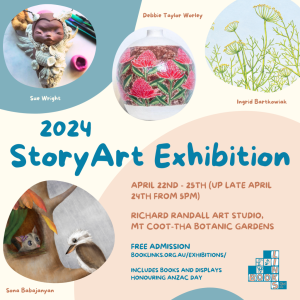
StoryArt Exhibition 2024 Meet the Artist: Ingrid Bartkowiak
The annual StoryArt Exhibition ran from Monday, April 22 until Thursday April 25 at the Richard Randall Art Studio at Mt Coot-tha, Brisbane. It was four fabulous days of art for everyone to enjoy.
This annual event showcases local artist-illustrators whose work includes creating beautiful books for children. The participants will have illustrations, models and other art for sale and on display.
This year’s artists were:
Deb Taylor-Worley Charlie’s War (written by Vicki Bennett)
Ingrid Bartkowiak Naturopolis (written by Deborah Frenkel)
Sona Babajanyan Goodnight Possum (written by Coral Vass)
Sue Wright will have polymer clay sculptures of mythical and fictional creatures
There will also be a display honouring ANZAC family stories (Jacqui Halpin, Australia Remembers)





 Can you tell us something about the pieces that you are going to exhibit at the Richard Randall Art Studio? Why did you choose these? Are any significant in any way?
Can you tell us something about the pieces that you are going to exhibit at the Richard Randall Art Studio? Why did you choose these? Are any significant in any way?


